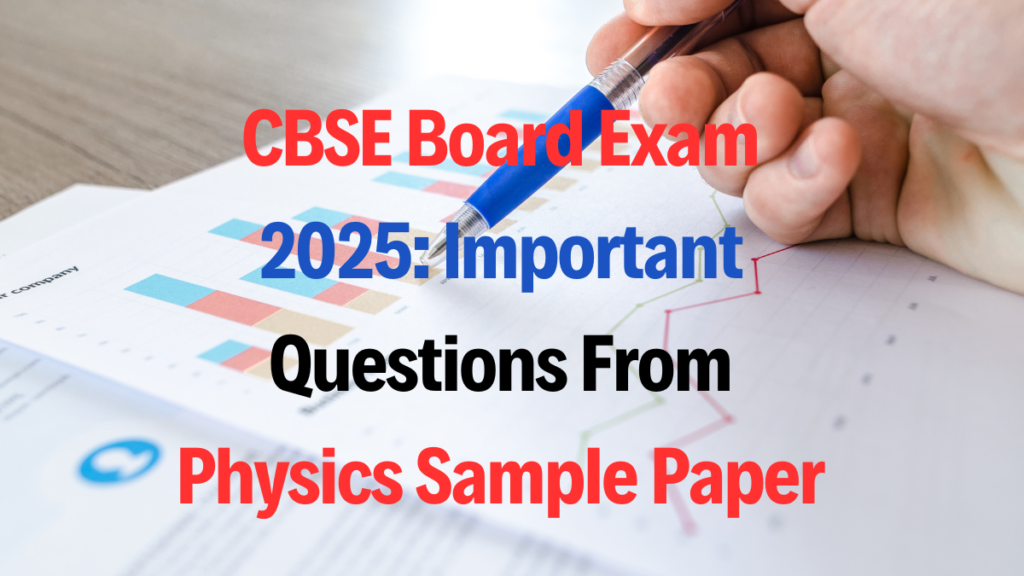
The Central Board of Secondary Education (CBSE) is conducting Class 10 and 12 board exams for the academic year 2025. The exams for the two classes began on February 15, 2025. The CBSE Class 10 exams started with English as the first subject, while the Class 12 exams began with Entrepreneurship. The Class 12 Physics exam is scheduled for February 21, 2025. This article highlights important questions from the CBSE Class 12 Physics sample paper to help students prepare effectively.
Read Also
AP Inter 1st Year Economics Guess Paper 2025
CBSE Class 12 Chemistry Exam 2025
TS Inter Theory Exams Hall Ticket 2025
UGC NET December 2024 Result Declared
AIIMS CRE Admit Card 2025 Released: Download Now, Exam from February 26
CBSE Board Exam 2025: Overview
The CBSE board exams are a crucial milestone for students across India. Every year, thousands of students appear for these exams, aiming for excellent results that pave the way for their future academic and career paths.
Key Highlights:
- Exam Start Date: February 15, 2025
- Class 12 Physics Exam Date: February 21, 2025
- Official Website: CBSE Official Website
Importance of Physics in Class 12 Board Exams
Physics is a core subject for students aspiring to pursue careers in engineering, medical sciences, research, and other technical fields. Scoring well in Physics can significantly boost the overall percentage and open doors to prestigious institutions.
Why Focus on Physics?
- Builds a strong foundation for competitive exams like JEE, NEET, and others.
- Enhances problem-solving and analytical skills.
- Crucial for understanding real-world applications of scientific principles.
Important Questions from CBSE Class 12 Physics Sample Paper 2025
1. Compound Microscope
A compound microscope consists of an objective lens of focal length 2.0 cm and an eyepiece of focal length 6.25 cm separated by a distance of 15 cm. How far from the objective should an object be placed in order to obtain the final image at:
- (a) the least distance of distinct vision (25 cm), and
- (b) infinity?
What is the magnifying power of the microscope in each case?
Solution Approach:
- Use lens formula: 1f=1v−1u\frac{1}{f} = \frac{1}{v} – \frac{1}{u}
- Calculate object distance for both cases.
- Determine magnifying power using the formula: M=vu×DfeM = \frac{v}{u} \times \frac{D}{f_e}
2. Giant Refracting Telescope
A giant refracting telescope at an observatory has an objective lens of focal length 15 m. If an eyepiece of focal length 1.0 cm is used, what is the angular magnification of the telescope in normal adjustment?
If this telescope is used to view the moon, what is the diameter of the image of the moon formed by the objective lens? The diameter of the moon is 3.48 ×\times 10^6 m, and the radius of the lunar orbit is 3.8 ×\times 10^8 m.
Solution Approach:
- Angular magnification: M=fofeM = \frac{f_o}{f_e}
- Image diameter: d=Dm×foRd = \frac{D_m \times f_o}{R}
3. A.C. Generator
Explain briefly, with the help of a labeled diagram, the basic principle of the working of an a.c. generator. In an a.c. generator, a coil of N turns and area A is rotated at an angular velocity ω\omega in a uniform magnetic field B. Derive an expression for the instantaneous value of the emf induced in the coil. What is the source of energy generation in this device?
Key Points:
- Principle: Electromagnetic induction.
- Formula derivation: e=NBAωsin(ωt)e = NBA\omega\sin(\omega t)
4. Transformer
With the help of a diagram, explain the principle of a device which changes a low AC voltage into a high voltage. Deduce the expression for the ratio of secondary voltage to the primary voltage in terms of the ratio of the number of turns of primary and secondary winding.
Additional Questions:
- (a) For an ideal transformer, obtain the ratio of primary and secondary currents.
- (b) Write any two sources of energy losses in actual transformers.
- (c) Does a step-up transformer violate the law of conservation of energy? Explain.
5. Ohm’s Law
Write two limitations of Ohm’s law. Plot their I-V characteristics.
6. Heating Effect
A heating element connected across a 100 V battery with 1 Ω\Omega internal resistance draws an initial current of 10 A at 20∘^{\circ}C. What is the power consumed by the battery at 320∘^{\circ}C?
Tips for Scoring High in Physics
- Understand Concepts: Focus on understanding rather than memorizing.
- Practice Numericals: Regular practice of numerical problems.
- Diagrams and Derivations: Draw neat diagrams and practice derivations.
- Revise Regularly: Make short notes for quick revision.
- Solve Sample Papers: Attempt sample papers and previous years’ questions.
Conclusion
Preparing for the CBSE Class 12 Physics exam requires dedication, regular practice, and a thorough understanding of concepts. By focusing on important questions from the sample paper, students can enhance their preparation and boost their confidence. Visit the official CBSE website for more resources and updates.
CBSE 2025, CBSE Board Exam, Class 12 Physics, Physics Sample Paper 2025, CBSE Physics Important Questions, Board Exam Preparation, CBSE Exam Tips, Physics Numericals, Physics Diagrams, CBSE Sample Paper Solutions, Board Exam 2025,
Stay tuned to RozgarVaani.com for the latest updates on CBSE exams, government job notifications, exam alerts, results, and more.
Disclaimer: The information provided on RozgarVaani.com is for general informational purposes only. While we strive for accuracy, please verify details from official sources. For any queries, contact us at hello@rozgarvaani.com.








